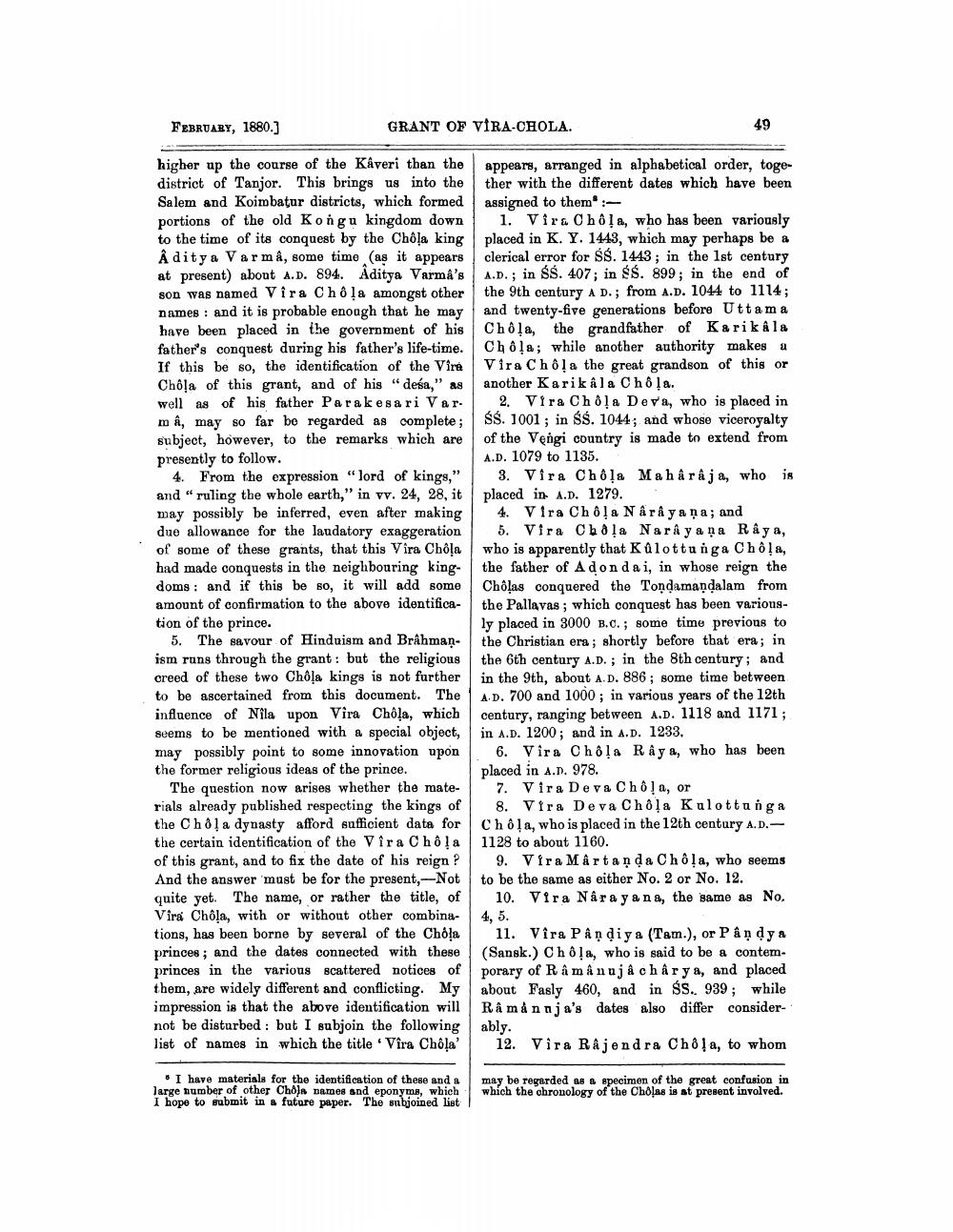________________
FEBRUABY, 1880.]
GRANT OF VIRA-CHOLA.
49
higher up the course of the Kaveri than the district of Tanjor. This brings us into the Salem and Koimbatur districts, which formed portions of the old Kongu kingdom down to the time of its conquest by the Chola king Aditya Varma, some time (as it appears at present) about A.D. 894. Aditya Varma's son was named Vira Chola amongst other names : and it is probable enough that he may have been placed in the government of his father's conquest during his father's life-time. If this be so, the identification of the Vire Chola of this grant, and of his "desa," as well as of his father Parakesari Var. mâ, may so far be regarded as complete; subject, however, to the remarks which are presently to follow.
4. From the expression " lord of kings," and "ruling the whole earth," in vv. 24, 28, it may possibly be inferred, even after making due allowance for the laudatory exaggeration of some of these grants, that this Vîra Chôļa had made conquests in the neighbouring kingdoms: and if this be so, it will add some amount of confirmation to the above identification of the prince.
5. The savour of Hinduism and Brâhman. ism runs through the grant: but the religious creed of these two Chôļa kings is not further to be ascertained from this document. The influence of Nila upon Vira Chôļa, which seems to be mentioned with a special object, may possibly point to some innovation upon the former religious ideas of the prince.
The question now arises whether the materials already published respecting the kings of the Chol a dynasty afford sufficient data for the certain identification of the Vira Chola of this grant, and to fix the date of his reign ? And the answer 'must be for the present,-Not quite yet. The name, or rather the title, of Vira Chôļa, with or without other combina- tions, has been borne by several of the Chôļa princes; and the dates connected with these princes in the various scattered notices of them, are widely different and conflicting. My impression is that the above identification will not be disturbed : but I subjoin the following list of names in which the title Vîra Chola'
appears, arranged in alphabetical order, together with the different dates which have been assigned to them :
1. Vira Chola, who has been variously placed in K. Y. 1443, which may perhaps be a clerical error for SS. 1443; in the 1st century A.D.; in SŚ. 407; in $. 899; in the end of the 9th century AD.; from A.D. 1044 to 1114; and twenty-five generations before Uttama Chola, the grandfather of Karikala Chola; while another authority makes a Vira Chô la the great grandson of this or another Karikala Chô la.
2. Vira Chola Deva, who is placed in $$. 1001; in $$. 1044; and whose viceroyalty of the Vergi country is made to extend from A.D. 1079 to 1135.
3. Vira Chola Maharaja, who is placed in. A.D. 1279.
4. Vira Chola Narayaņa; and
5. Vira Chola Nará y a na Raya, who is apparently that Külottu iga Chola, the father of Adonda i, in whose reign the Chôļas conquered the Tondamandalam from the Pallavas; which conquest has been various ly placed in 3000 B.C.; some time previous to the Christian era; shortly before that era; in the 6th century A.D.; in the 8th century; and in the 9th, about A.D. 886; some time between AD. 700 and 1000; in various years of the 12th century, ranging between A.D. 1118 and 1171 ; in A.D. 1200; and in A.D. 1233.
6. Vira Chola Raya, who has been placed in A.D. 978.
7. Vira Deva Chô! a, or
8. Vira Deva Chola Kulottunga Chô la, who is placed in the 12th century A.D.1128 to about 1160.
9. Vira Mårtan da Chola, who seems to be the same as either No. 2 or No. 12.
10. Vira Narayana, the same as No. 4, 5.
11. Vira Pån diya (Tam.), or Pân dya (Sansk.) Chô! a, who is said to be a contemporary of Ramanuja charya, and placed about Fasly 460, and in ss.. 939; while Râmånaja's dates also differ considerably.
12. Vira Rajendra Chola, to whom
. I have materials for the identification of these and a large number of other Chola Dames and eponyms, which I hope to submit in a future paper. The subjoined list
may be regarded as specimen of the great confusion in which the chronology of the Cholas is at present involved.




